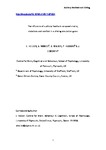The influence of auditory feedback on speed choice, violations and comfort in a driving simulation game
| dc.contributor.author | Hellier, Elizabeth | |
| dc.contributor.author | Naweed, A | |
| dc.contributor.author | Walker, G | |
| dc.contributor.author | Husband, P | |
| dc.contributor.author | Edworthy, Judy | |
| dc.date.accessioned | 2012-06-15T10:34:00Z | |
| dc.date.accessioned | 2012-06-15T10:42:40Z | |
| dc.date.available | 2012-06-15T10:34:00Z | |
| dc.date.available | 2012-06-15T10:42:40Z | |
| dc.date.issued | 2011-11 | |
| dc.identifier.issn | 1369-8478 | |
| dc.identifier.uri | http://hdl.handle.net/10026.1/1033 | |
| dc.description.abstract |
Two experiments are reported which explore the relationships between auditory feedback (engine noise), speed choice, driving violations and driver comfort. Participants played a driving simulation game with different levels of auditory feedback in the form of engine noise. In Experiment 1, a between-subjects design revealed that no noise and low levels of engine noise (65 dB(A)) resulted in participants driving at faster speeds than in the medium (75 dB(A)) and high (85 dB(A)) levels of engine noise conditions. The low noise feedback conditions were also associated with decreases in driver comfort. Experiment 2 also demonstrated that low levels of engine noise feedback (no feedback and 70 dB(A)) were associated with increases in driving speed, and driving violations relative to higher levels of feedback (75 dB(A) and 80 dB(A)). Implications exist for current car manufacturing trends which emphasise a growing increase in noise insulation for the driver. © 2011 Elsevier Ltd. All rights reserved. | |
| dc.format.extent | 591-599 | |
| dc.language | en | |
| dc.language.iso | en | |
| dc.publisher | Elsevier BV | |
| dc.relation.replaces | http://hdl.handle.net/10026.1/1032 | |
| dc.relation.replaces | 10026.1/1032 | |
| dc.subject | Auditory feedback | |
| dc.subject | Driving | |
| dc.subject | Noise | |
| dc.subject | Comfort | |
| dc.title | The influence of auditory feedback on speed choice, violations and comfort in a driving simulation game | |
| dc.type | journal-article | |
| dc.type | Journal Article | |
| plymouth.author-url | https://www.webofscience.com/api/gateway?GWVersion=2&SrcApp=PARTNER_APP&SrcAuth=LinksAMR&KeyUT=WOS:000297442800016&DestLinkType=FullRecord&DestApp=ALL_WOS&UsrCustomerID=11bb513d99f797142bcfeffcc58ea008 | |
| plymouth.issue | 6 | |
| plymouth.volume | 14 | |
| plymouth.publication-status | Published | |
| plymouth.journal | Transportation Research Part F: Traffic Psychology and Behaviour | |
| dc.identifier.doi | 10.1016/j.trf.2011.07.004 | |
| plymouth.organisational-group | /Plymouth | |
| plymouth.organisational-group | /Plymouth/Faculty of Health | |
| plymouth.organisational-group | /Plymouth/REF 2021 Researchers by UoA | |
| plymouth.organisational-group | /Plymouth/REF 2021 Researchers by UoA/UoA04 Psychology, Psychiatry and Neuroscience | |
| plymouth.organisational-group | /Plymouth/Research Groups | |
| plymouth.organisational-group | /Plymouth/Research Groups/Centre for Brain, Cognition and Behaviour (CBCB) | |
| plymouth.organisational-group | /Plymouth/Research Groups/Centre for Brain, Cognition and Behaviour (CBCB)/Behaviour | |
| plymouth.organisational-group | /Plymouth/Users by role | |
| dc.rights.embargoperiod | Not known | |
| rioxxterms.versionofrecord | 10.1016/j.trf.2011.07.004 | |
| rioxxterms.licenseref.uri | http://www.rioxx.net/licenses/all-rights-reserved | |
| rioxxterms.type | Journal Article/Review |


